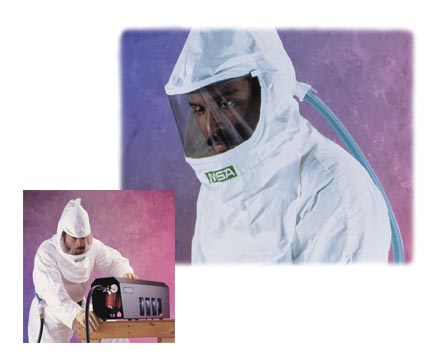Chemical Hazards endanger
pharmaceutical company workers
People who take one or more medications usually think about their
positive effects, side effects, and how much they cost. At MSA,
we think about how MSA associates and products help to make the
pharmaceutical industry a safer place for its workers.
The raw materials used in the manufacture of ingredients later
used to make pharmaceutical products may be mixed together in
huge drums and vats. Some chemicals are very dangerous, and they
can escape into the air as a vapor or powder. Most of the hazards
occur during researching and manufacturing the compounds which
will be used in the later manufacture of the finished drug-type
products.
One large pharmaceutical corporation with several large facilities
in the mid-Atlantic area is served by our distributor Fisher Safety
teamed with MSA sales personnel.
MSA regional sales manager Dave McArthur explained, “In
some pharmaceutical manufacturing applications, the materials
they work with are more hazardous than an air-purifying respirator
can handle. Also, they need something that is comfortable, cool,
easy to wear, and easy to see through that they can wear for hours
at a time.”
“These workers are happy with our Versa-Hood™ Air-Supplied
Hood. This lightweight, cool, and quiet system features a Tyvek
hood and lightweight air hoses. Workers like the comfortable knit
collar and choice of shoulder- or waist-length style. The Versa-Hood
unit is available in uncoated and Saranex-coated versions (because
some exposures are more hazardous than others). Of course, we
help them set up appropriate air-supply assemblies.”
A facility that makes multiple drugs has to guard against cross-contamination.
For example, workers who go from one area into another must first
change (or clean) their protective coverings, respiratory protection,
and other equipment.
MSA rep Jim Treat reported, “At the New Jersey facility I
visit, workers wear tight-fitting facepieces with constant-flowing
air-line respirators as well as the Versa-Hood units.”
From Virginia, MSA rep Rick Graham commented, “We sell many
different products to detect hazards and protect the workers.
The huge facilities in my area must cope with volatile organic
compounds, and photoionization detectors like our Passport®
PID II Organic Vapor Monitor are in demand.
“My customers like the Versa-Hood model with and without
the adjustable valve. Workers in areas with fewer hazards wear
our air-purifying respirators, with Comfo® and Ultra-Twin®
facepieces.”
Depending on the specific application, both portable and permanent
instruments can detect and monitor many of the pharmaceutical
industry’s problem contaminants.
Portable instruments product line manager Ron Baughman and sales
manager Victor Vendetti recommend the FiveStar® Alarm to detect
hexane, toluene, and oxygen deficiency. The Passport® PID
II Monitor finds low-level leaks of acetic acid, isopropyl alcohol,
toluene, etc. And detector tubes are used with the Kwik-Draw®
or Escort ELF® Pump to detect formaldehyde, benzene, hydrogen
cyanide, etc.
Permanent instrument group manager Len Blatnica named the Ultima®
Plus Digital Network System, the Model 3800 Infrared Gas Monitor,
and the Toxgard® II Gas Monitor as permanently installed monitors
that can be used to detect different hazardous gases in pharmaceutical
facilities.
Ask for a copy of our new catalog for the pharmaceutical industry
by calling 1-800-MSA-2222.
|







